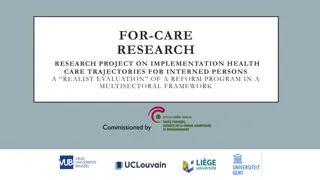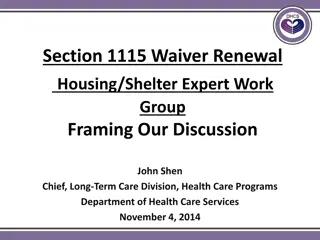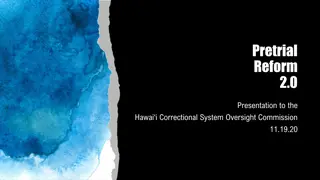Investment Strategies for Meaningful Reform in Healthcare: Insights by John Allan
John Allan, Executive Director of MHAODB Queensland, advocates for strategic investments in areas like education, consumer empowerment, and health service standards for impactful reform. The discussion delves into drivers of change, the importance of leadership, and successful approaches to address challenges in healthcare settings.
Download Presentation

Please find below an Image/Link to download the presentation.
The content on the website is provided AS IS for your information and personal use only. It may not be sold, licensed, or shared on other websites without obtaining consent from the author. Download presentation by click this link. If you encounter any issues during the download, it is possible that the publisher has removed the file from their server.
E N D
Presentation Transcript
Where best to invest to enable meaningful reform by John Allan Executive Director MHAODB Queensland President Elect RANZCP www.equallywell.org.au
best return on investment This is a call to arms develop focus areas for reform such as education consumer empowerment health service standards service development applied to your current role and context three examples of different types and tips www.equallywell.org.au
What drives change? Leadership Change in human behaviour Incentive Money A good idea Policy and evidence are necessary but not always the drivers The burning platform may be more about establishing a compelling story than crisis and seeking to sustain not just initiate www.equallywell.org.au
Top-Down to lead Bottom-Up National project on Reduction and where possible elimination of seclusion and restraint to The Elimination of Restrictive Practices Show graph Success necessary, combined leadership, common goal, publication of data common definitions , stated strategy 10 year process of attitude and behaviour change tangible feedback mechanism, overcame fear and stigma to shine a light on something, the target behaviour was not the stated goal (reduction in seclusion) but processes much further up the line (welcoming and recovery) Problems variation in response and uptake, arguments why we can t change www.equallywell.org.au
Bottom-Up to show Top-Down something new Indigenous smoking Indigenous Queenslander adults were 2.5 timesmore likely tosmoke daily than non-Indigenous adults. 75% of indigenous consumers smoke www.equallywell.org.au
Bottom-Up recognised by Top-Down as mutual benefit Queensland Clinical Collaborative and QUIP payments to increase awareness of smoking and place people on pathways to quitting in a clinical setting Success: came from problem identified by people on the floor, offered a tangible incentive to overcome ambivalence and allowed pride in changing behaviour while tackling the fear (what if he gets violent), makes both people effective, fit with a policy opportunity Problems when leadership is lacking, continuation of effort, cost afterwards not always covered, what about everything else? www.equallywell.org.au
The role of Public Policy Public policy refers to the principles that underpin courses of action, regulatory measures, laws, and funding priorities promulgated by a governmental entity i.e. administrative and executive branches The main aim of health public policy is to create a supportive environment to enable people to lead healthy lives and is characterized by an explicit concern for health and equity www.equallywell.org.au
Who actually drives the reform agenda? You do more than you think Some common beliefs Clinicians have little say Non clinicians aren t genuine Letters to the minister have weight Every decision is logical Unsolicited proposals fail, personal representation is impossible Most decisions are made in a logical policy flow usually in response to evidence or pressure (scandal, media, political pressure e.g. elections) www.equallywell.org.au
Policy tips for the Smoking in mental health initiative Work out who is addicted to what Join with an accepted program e.g. physical health care Respect your partner s capacity to bring a fresh set of ideas which may challenge you Endlessly talk to your critics they might change Get noticed by others- they may want to give you money Identify your leaders who may not always be obvious Introduce evidence but be patient www.equallywell.org.au
Advocacy isnt just a matter of presenting the overwhelming facts other barriers Conflation of argument Culture Myths Ambivalence Implementation fatigue Isolation Resource priorities Confirmation biases Self serving biases www.equallywell.org.au
Critical factors for success More than one strategy Do not over rely on one person or pathway Consumers are more valuable to influence opinion than professionals in certain instances only Good for awareness Less so for action www.equallywell.org.au























